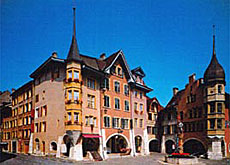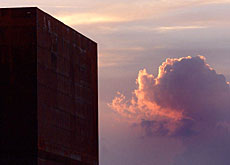Biel reveals its hidden charms

Biel presented itself in its best light last year when it was one of four sites for Switzerland’s national exhibition, Expo.02.
But with the exhibition gone, Switzerland’s only officially bilingual town is struggling to attract tourists, who are put off by its – undeserved – image as a lacklustre industrial centre.
For many visitors, the first views of Biel – or Bienne to give it its French name – are bland shopping streets and office blocks – a far cry from the picturesque approach to Expo’s other host towns such as Murten and Neuchâtel.
But the small town in north-western Switzerland has many attractions to offer anyone willing to look a little bit harder – including a pretty old quarter, a thriving arts scene, lakeside activities and easy access to the Jura mountains.
“One of the big problems is that neither of Biel’s main attractions – the lake and the old town – are next to one another and visitors don’t automatically stumble upon either,” Samuel Kocher, the head of Biel Tourism, told swissinfo.
“But during Expo we had very positive feedback from those visitors who decided to explore the town itself rather than just the exhibition.”
Old charm
Biel’s old town, about ten minutes walk from the station, is a tiny haven of narrow lanes, gothic architecture, cosy restaurants and boutiques.
The town’s unique bilingual flair is apparent everywhere, from the dual-language street names to the style of buildings, many of them dating from the 1500s.
“This is Obergasse, or Rue Haute, which I think is the only place in Switzerland where one side of the street is flanked by arched, Germanic-style buildings, and opposite it’s French with steps leading up to the doors,” said Kocher.
“The two literally sit side by side – just like the town’s language groups,” he boasted. “Here you can hear conversations between two people conducted in a mixture of French and German, or in any one of 55 languages.”
The town’s bilingual origins lie in the 19th century when both French and German-speaking craftsmen flocked to its watchmaking workshops. More recently, a large immigrant population has also settled in Biel.
This cultural diversity means that Biel makes up in friendliness and openness what it lacks in tourist landmarks. “It may not be the most exciting place but it’s very relaxed and open,” said 18-year-old Susanne Kohler, a student.
Art scene
One of the town’s biggest surprises is its high concentration of museums, most of them clustered around the leafy suburb just outside the old town.
The Neuhaus museum boasts an eclectic collection of artefacts relating to Biel’s history – as well as an excellent restaurant – while the Museum Schwab has archaeological remains and changing exhibitions.
But the most outstanding example is the Centre PasquArt, which has already gained a strong reputation for cutting-edge contemporary art just three years after it opened.
“We try to get artists from both French and German-speaking Switzerland, as well as international names,” museum director Dolores Delano told swissinfo.
“We have six to ten temporary exhibitions at any one time and no permanent collection so that keeps things ticking over fast.”
Image problem
Biel is an ideal launch pad to the region’s vineyards and there are cable cars from the centre of town to the Jura mountains. And of course, there are plenty of boat outings to be done on Lake Biel.
Despite these assets, Biel has yet to prove itself as a tourist destination. “Biel’s image as an industrial centre has always been a problem but it’s becoming less so since Expo,” Kocher said hopefully.
The town was given a facelift thanks to an investment of SFr150 million ($113 million), which went towards infrastructure and transport links, some of which was also spent on sprucing up some of the town’s shopping areas.
But the signs are it will take a lot more to convince tourists to head for Biel.
swissinfo, Vanessa Mock
The city of Biel has struggled to shake off its image as a dull industrial town, despite the positive attention it received during Switzerland’s national exhibition.
Switzerland’s only official bilingual town offers a number of diverse attractions, including an attractive old quarter, art museums, lakeside activities and easy access to the Jura mountains.
The old town offers impressive architecture along with a variety of cosy restaurants and boutiques.
Stroll in the old town with its fountains, guild halls and a Gothic church dating from the 1500s.
Visit the ‘culture quarter’, with the Neuhaus and Schwab museums and the Centre PasquArt.
Hop on a boat for a trip on the lake.
Visit Friday’s event looking back at Expo.02.

In compliance with the JTI standards
More: SWI swissinfo.ch certified by the Journalism Trust Initiative

You can find an overview of ongoing debates with our journalists here. Please join us!
If you want to start a conversation about a topic raised in this article or want to report factual errors, email us at english@swissinfo.ch.